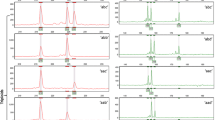Abstract
Artificial polyploidy could be an important means of genetic enhancement in the species where plant biomass is the source of economic product. However, success of polyploidy approach becomes limited if the seeds are the principal means of reproduction, since the seeds so produced could be genetically imbalanced owing to disturbances in meiosis. The present study provides an illustrated account of successful induction of autotetraploidy, morphometric details of the induced polyploid, and its stability over generations through seed progenies in an important medicinal plant, Withania somnifera (L.) Dunal (fam. Solanaceae). Meiotic analyses of the progenitor diploid and its derived autotetraploid revealed that the induced tetraploid sports high bivalent pairing in the C0 generation and its subsequent enhancement over subsequent generations (C1, C2), coupled with reduced genetic segregation. Detailed analysis of meiotic configurations show that low chiasmate association in the progenitor diploid facilitates high bivalent pairing in the autotetraploid, and thus balanced meiosis and improved seed fertility in the tetraploid. Further, the perennial breeding habit of W. somnifera and tetrasomic pattern of inheritance in the induced tetraploid offer a unique opportunity for fixation of heterozygosity by way of using C0 as a the nuclear stock to realize C1 seeds for propagation without losing polyploid heterosis.


Similar content being viewed by others
References
de Peer YV, Mizrachi E, Marchal K. The evolutionary significance of polyploidy. Nat Rev Genet. 2017;18(7):1–14. https://doi.org/10.1038/nrg.2017.26.
Dhawan OP, Lavania UC. Enhancing the productivity of secondary metabolites via induced polyploidy: a review. Euphytica. 1996;87(2):81–9.
Galitski T, Saldanha AJ, Styles CA, Lander ES, Fink GR. Ploidy regulation of gene expression. Science. 1999;285:251–4.
Gupta P, Goel R, Agarwal AV, Hasan Asif M, Sangwan NS, Sangwan RS, Trivedi PK. Comparative transcriptome analysis of different chemotypes elucidates withanolide biosynthesis pathway from medicinal plant Withania somnifera. Sci Rep. 2015;5:18611.
Lattoo SK, Dhar RS, Khan S, Bamotra S, Dhar AK. Temporal sexual maturation and incremental movement encourages mixed mating in Withania somnifera—an insurance for reproductive success. Curr Sci. 2007;92:1390–9.
Lavania UC. Genesis of high bivalent pairing in autotetraploids and autotriploids, and reduction in bound arm associations over generations. In: Kew Chromosome Conf. IV. Kew: Royal Botanic Gardens; 1995. pp. 397–406.
Lavania UC. Genomic and ploidy manipulation for enhanced production of phytopharmaceuticals. Plant Genet Resour. 2005;3:170–7.
Lavania UC. Polyploidy, body size and opportunities for genetic enhancement and fixation of heterozygosity in plants. Nucleus. 2013;56(1):1–6.
Lavania UC, Srivastava S, Lavania S. High bivalent frequencies in the autotetraploids of aromatic grass, Cymbopogon martini (Roxb.) Wats facilitates polyploid stability. Adv Chromosome Sci (Daegeon, Korea). 2006;2:9–18.
Lavania UC, Srivastava S, Lavania S. Ploidy mediated reduced segregation facilitates fixation of heterozygosity in the aromatic grass Cymbopogon martini (Roxb.). J Heredity. 2010;101(1):119–23.
Lavania UC, Srivastava S, Lavania S, Basu S, Misra NK, Mukai Y. Autopolyploidy differentially influences body size in plants, but facilitates enhanced accumulation of secondary metabolites, causing increased cytosine methylation. Plant J. 2012;71:539–49.
Singh S, Kumar S. Withania somnifera: the Indian ginseng ashwagandha. Lucknow: Central Institute of Medicinal and Aromatic Plants; 1998. p. 293.
Soltis DE, Visger CJ, Soltis PS. The polyploidy revolution then…and now: Stebbins revisited. Am J Bot. 2014;101(7):1057–78.
Srivastava S, Lavania UC, Sybenga J. Genetic variation in meiotic behaviour and fertility in tetraploid Hyoscyamus muticus: correlation with diploid meiosis. Heredity. 1992;68:231–9.
Sybenga J. Meiotic configurations. Berlin: Springer; 1975.
Vidya KM, Hegde L, Saraswathi G, Vijay Kumar BM. Induction and identification of autotetraploidy in ashwagandha (Withania somnifera Dunal). Asian J Hortic. 2013;8:32–5.
Acknowledgements
I am grateful to Dr U.C. Lavania, my Ph.D. mentor under whom this work was conducted.
Author information
Authors and Affiliations
Corresponding author
Rights and permissions
About this article
Cite this article
Basu, S. Meiotic correlations and bound arm associations between the diploid and autotetraploid of Withania somnifera (L.) Dunal, and implications on genetic stability. Nucleus 62, 15–20 (2019). https://doi.org/10.1007/s13237-018-0251-x
Received:
Accepted:
Published:
Issue Date:
DOI: https://doi.org/10.1007/s13237-018-0251-x




